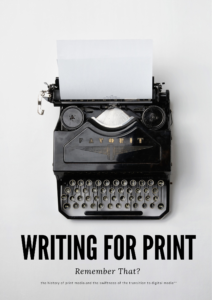Curious about the new artificial intelligence-based app, Chat-GPT, and the future of your job? By the end of this article, we hope you’ll be reassured that human writers are still needed, and be encouraged to learn how AI can actually help your content.
By this point, you likely have heard of Chat-GPT, the artificial intelligence (AI) app just released that’s set to change how we educate ourselves, do business, market, and more.
Some writers cringe in fear at the prospect of being challenged, if not entirely replaced, by AI.
But we think all the anxiety is overblown…
In fact, AI can be very helpful.
Today we will explore why Chat-GPT isn’t your bitter rival as a writer, but instead a very handy helpmate.
Whether you’re a seasoned writer or a complete beginner, this post suggests ways for you to leverage Chat-GPT correctly to move your game forward.
What Is Chat-GPT?
Chat-GPT is a system that uses artificial intelligence for multiple functions.
Some of these functions include answering questions (that we used to Google), offering advice, creating code, and even writing copy.
Chat-GPT was developed by OpenAI and released in November of 2022. Since then, writers’ views on the matter have been divided between the positive potential and the potential dangers of the tool.
What makes Chat-GPT unique is that it generates human-like responses based on “prompts” that users enter.
It looks at thousands of resources from the internet to patch together detailed, high-quality responses.
From a content creation standpoint, Chat-GPT does a lot (It’s no secret why it’s becoming popular). So much so that many writers and creatives are growing concerned about this software potentially replacing them in the careers they’ve worked so hard for.
Fortunately, this doesn’t have to be the case.
In fact, you can use this technology to be a better and more efficient writer.
Let’s look at 6 reasons why Chat-GPT isn’t a threat to you as a writer or creative professional.
6 Reasons Why Chat-GPT Is Not A Threat To Writers And Creatives
It’s time for some serious truth.
1. Chat-GPT Lacks The Human Touch that People Seek
While Chat-GPT can generate quality content, it lacks the human touch many people look for in writing. It’s not uncommon to get responses that come off as robotic, or that lack an emotional “kick” to them.
This can be a problem, especially if you’re a content creator whose job is to persuade and influence readers.
Without emotional words, phrases, perspectives, and metaphors, a Chat-GPT-generated message often falls short.
While it can generate glimpses of persuasive style, so far only human writers can understand the audience you’re writing to and relate to their specific experiences and needs.
By doing this naturally, human writers can pack the emotional punch necessary for a persuasive message.
2. It’s All About The Right Inputs
Also, Chat-GPT is only as good as the inputs or “prompts” it receives.
If the inputs are generic or irrelevant, so will the content be (and even with very “specific” prompts, you will still need to fact check and make edits!)
Human writers are needed to create targeted, detailed prompts to get quality content out of Chat-GPT.
Writers who know how to enter quality prompts will remain very valuable.
This extra skill set will be the real differentiator between the writers who succeed with the tool and those who don’t.
3. Chat-GPT Has Limitations
Chat-GPT can’t generate content beyond the information it knows.
Some niche or “underground topics” are hard to produce content with using Chat-GPT.
The result?
The software may only produce a small amount of content on a niche topic – or none altogether.
Another issue is that Chat-GPT often misses nuance and context. A great example is when the app confuses similar topics.
4. Chat-GPT Lacks The Creativity Human Writers Have
Creativity is very difficult to replace with AI.
After all, each one of us has unique perspectives that bring new ideas. Tomorrow’s ideas will come from humans that look at problems from different angles.
Writers who use their creativity in conjunction with Chat-GPT content will be effective. But the likelihood of Chat-GPT completely outmatching human creativity is slim or none.
5. Chat-GPT Makes Informational Errors
Chat-GPT can sometimes give inaccurate information. For an information writer, this can be disastrous.
Chat-GPT is only as accurate as the data it picks up across the web. There are several reasons to be careful here. The web is full of garbage, and sometimes Chat-GPT also will receive out-of-date information.
Only human writers have the ability to question information that seems wrong or outdated, then verify through further research and add context to the information they find. If you’re using Chat-GPT, detailed fact-checking will be absolutely essential.
6. Chat-GPT Often Gives Fluff Or Vagueness
Lastly, Chat-GPT sometimes produces answers that are vague or lack substance.
It won’t always be able to provide in-depth knowledge on a topic.
This results in a response with many filler words and repetitive sentences (Overall, content no one wants to read).
So as a writer, it’s important to use Chat-GPT only as an assistant – a tool – rather than your end-all-be-all.
Now let’s look at the upside: ways to use Chat-GPT to your advantage.
Different Ways Writers Can Use Chat-GPT As An Asset
Generating Content Ideas
Sometimes a big challenge you face as a writer is developing content ideas.
Chat-GPT is a sound tool for creating content and finding content angles. And the best part is that it all begins by entering a detailed, highly-targeted prompt.
Helping With Research
Although Chat-GPT’s information isn’t always 100% accurate, it can give you a good enough start on which to base your research.
Combining what it produces with research of your own can help reduce the time it takes to understand a topic.
Improving Writing Skills
Chat-GPT can also help writers improve writing quality and skills.
You can ask it to suggest edits for your writing (and you will notice improvements in grammar, sentence structure, and more!) This is a helpful way of improving the quality of your written work. (Of course, free tools like Grammarly do this equally well.)
Seeing Opposing Arguments
For copywriters and persuasive writers, seeing opposing viewpoints is an excellent way of creating a strong argument.
You can use Chat-GPT to help you develop opposing arguments that you can later use in your writing.
For example, say you’re creating a landing page.
You can develop objection questions (from the opposing argument) for your FAQ section. You can add a response under the questions to help visitors overcome their own objections about your product or service.
Expanding Your Thought Process
We’ve all gone through it…
When it’s hard to find the words and delve into more detail about something.
Entering what you’re trying to explain into Chat-GPT is a helpful way of expanding a subject so you can wrap your human mind around it better.
The best part is you can generate even more ideas based on the Chat-GPT response.
The benefit here is potentially a new technique to overcome the dreaded “writer’s block” and get your thoughts down in an organized way.
8 Best Practices When Using Chat-GPT As A Tool
- Edit to match natural human communication – Make sure tone, sentence pacing, and words match how a normal human would write or speak. This helps make your writing more digestible.
- Remove writing “fluff” – Edit Chat-GPT’s output to keep your writing succinct and to the point. Avoid “filler” words or words that don’t add value to the message. Strike any repetition the app coughs up.
- Brainstorm ideas and then expand on them – Take what the software gives you and expand on it using your own knowledge and creativity. This can help you make your written word more valuable to readers by combining breadth and depth of information.
- Get specific with your inputs – Be as detailed as possible with the questions you want Chat-GPT to answer. Consider how much information you need, the style in which you want it presented, and who you’re writing to.
- Use it with other writing software – Remember to keep multiple writing tools in your toolbox. Using Chat-GPT in tandem with editing software like Grammarly or Hemingway is a better way to ensure top-notch content.
- Always proofread – As intelligent as Chat-GPT is, always proofread for coherence, syntax, and logic. Take the sections that have the most value and eliminate those that don’t.
- Verify facts – Don’t forget to add research to what Chat-GPT is giving you. As mentioned earlier, some information can be outdated or completely false.
- Get clear on the goal of each written piece – Knowing the “why” behind what you’re writing will help you structure written pieces better. It’ll also make it easier to enter detailed prompts into Chat-GPT, which will help you get your message across well.
Chat-GPT’s Impact On Writing Going Forward
The rise of Chat-GPT has made headlines across multiple industries.
Despite the reaction in the content community, we at The Allyson Group think it’s arrival does not signal the end for human writers, but is rather a sign of an opportunity.
It’s a chance for human writers to expand their capabilities, improve their writing, and work smarter.
Content planning has never been more efficient, especially if you partner with humans that know all about your subject.
That’s where The Allyson Group comes in.
The Allyson Group and my team of writers help you produce professional-grade blogs, website content, and print communications (Brochures, press releases, and more.)
Want some content planning ideas?
I have a few 30-minute blocks open on my calendar for us to have a chat.
In our convo, I’ll learn more about your business goals and share how we can help you reach them through stronger content.
You can schedule your consultation with me here.












